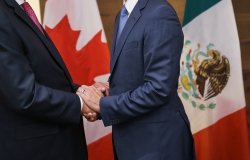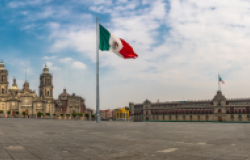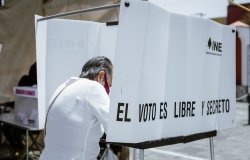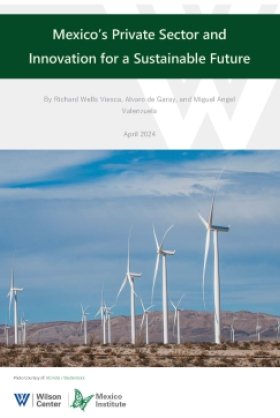The Right to Information: Challenges and Opportunities in Mexico
Overview
 Mexico has one of the most advanced freedom-of-information laws in the world, yet its implementation is hindered by an "opacity consensus" that encourages government stonewalling. And, despite the law's enshrinement in the Mexican constitution, its benefit to non-journalist Mexicans is difficult to measure—largely because the spirit of the federal law is poorly facilitated by secondary legislation at the state level.
Mexico has one of the most advanced freedom-of-information laws in the world, yet its implementation is hindered by an "opacity consensus" that encourages government stonewalling. And, despite the law's enshrinement in the Mexican constitution, its benefit to non-journalist Mexicans is difficult to measure—largely because the spirit of the federal law is poorly facilitated by secondary legislation at the state level.
The law, known by its initials as LFTAIPG and ratified as a constitutional amendment in 2008, is "very strong," said Andrew Selee, director, Woodrow Wilson Center Mexico Institute. Yet at the same time, "there is a strong inertia in the other direction," and a defensive posture prevails among many authorities, whose first impulse upon receiving an access petition is to close ranks.
 Gabriela Morales, Article-19 México, discussed challenges and strengths to the transparency regime in Mexico. She cited what she called two main weaknesses in the law. The federal commission created by LFTAIPG lacks enforcement power, and its resolutions are non-binding. As a result, agencies can ignore an access request and not face legal consequence. Another weakness, she said, was agency stonewalling, a delaying tactic, which can draw out the petition process for up to two and a half years, possibly making the terms of the initial submission obsolete. Still, the law has strengths, she said. For journalists, it has facilitated their work, particularly those who cover the police and courts. For example, access requests have elicited data demonstrating the inefficiency of the criminal justice system; one such piece of information is a statistic showing that at any one time only 5 percent of homicides are under investigation, she said.
Gabriela Morales, Article-19 México, discussed challenges and strengths to the transparency regime in Mexico. She cited what she called two main weaknesses in the law. The federal commission created by LFTAIPG lacks enforcement power, and its resolutions are non-binding. As a result, agencies can ignore an access request and not face legal consequence. Another weakness, she said, was agency stonewalling, a delaying tactic, which can draw out the petition process for up to two and a half years, possibly making the terms of the initial submission obsolete. Still, the law has strengths, she said. For journalists, it has facilitated their work, particularly those who cover the police and courts. For example, access requests have elicited data demonstrating the inefficiency of the criminal justice system; one such piece of information is a statistic showing that at any one time only 5 percent of homicides are under investigation, she said.
 Guillermo Noriega of Sonora Ciudadana agreed with Selee and Morales in considering LFTAIPG among the highest right-to-information standards in the world. Yet within state government there is still opacity and stonewalling, he said. This is because "powerful interests" realize that enhanced transparency is inconvenient. At the same time, Noriega also remarked on gains obtained by the law, especially regarding public finances. In Sonora state for example, information obtained through the formal transparency request process revealed a $400,000 contract for a flamenco dance performance, considered over-the-top.
Guillermo Noriega of Sonora Ciudadana agreed with Selee and Morales in considering LFTAIPG among the highest right-to-information standards in the world. Yet within state government there is still opacity and stonewalling, he said. This is because "powerful interests" realize that enhanced transparency is inconvenient. At the same time, Noriega also remarked on gains obtained by the law, especially regarding public finances. In Sonora state for example, information obtained through the formal transparency request process revealed a $400,000 contract for a flamenco dance performance, considered over-the-top.
"Information is power," Noriega said, and enhancing the public's right to know pays indirect benefits, since it allows citizens to see democracy in action. When a citizen files a successful access request, he obtains greater confidence in the democratic system, Noriega said. He added that greater government transparency won't happen merely from a unilateral policy shift at the top but will be facilitated by a bottom-up push from advocates and the public.
Miguel Pulido of Fundar identified main challenges facing the system of government transparency in Mexico. The first was the disjuncture between the ideals of the federal freedom-of-information law, enshrined in the Mexican constitution, and the secondary legal framework at the state level. The drafters of the 2008 federal law represented a forward-thinking vanguard championing transparency and the public's right to know, but legislators at the state level have a different set of immediate priorities and objectives, he said. This disjuncture is the principal challenge facing efforts to enhance transparency, and it results in an opacity that leads to poor policy outcomes. Violent crime, he said, could be considered one such outcome, resulting from a lack of accountability of police operations and budgets over decades. In closing, Pulido noted that Mexican government has yet to establish a foundational public policy of openness, in spite of the law changes.
Kate Doyle, senior analyst of U.S. policy in Latin America for the National Security Archive, stressed recent gains in government transparency in Mexico. "Although it's difficult to notice from the trenches, Mexico is in fact a model and remains a model," she said. Doyle cited specific cases, such as the fact that in Mexico patients have the right to verify the board-certification of a physician, and she noted there have been advances in terms of public finance oversight. Yet there are challenges, she said. Measuring transparency law comparatively across the 32 states is one such challenge, especially considering the high differentiation among the states in policies and approaches. Echoing Noriega's comments, she noted that many local actors are unsure of the benefits of transparency and are unwilling to abandon retrograde approaches to the management of government information. She stressed the role of the press in communicating to the public the benefits of greater transparency.
The disjuncture between informal bureaucratic rules—the "opacity consensus" mentioned by Noriega—and formal laws, such as LFTAIPG, represents a major barrier to the public's right to know, said Daniel Sabet, visiting professor, Department of Political Science, Georgetown University. Echoing Noriega, Sabet added that a "grassroots push" is needed to force authorities to put into place an authentic public information system.
Sabet also identified methodological challenges to measuring the effectiveness of transparency law. The first major hurdle, he said, is determining a method to operationalize the abstraction of transparency and to ground the concept in empirical knowledge. Another challenge lies in depoliticizing information requests, so that petitions are not seen as partisan weapons and so that the release of public information becomes a regular and routine expectation from administration to administration.
In the question-and-answer session, panelists emphasized the transparency advances made through LFTAIPG. They stressed that the law is recent—ratified as an amendment only in 2008—and that its inability to reverse decades of government opacity shouldn't be an indictment. They added that Mexicans shouldn't be fooled by foreigners' praise for the law, and that Mexico faces a series of tough challenges standing in the way of improved implementation. Panelists credited the media for promoting the public's right to know, and Morales suggested that journalists could be a counterweight to "the inertia of opacity." Doyle added that the freedom-of-information law "is not a pole vault, to leap over structural challenges," rather than it is one tool.
Drafted by Robert Donnelly, Program Associate, Mexico Institute
Andrew Selee, Director, Mexico Institute. Ph: (202) 691-4088
Hosted By

Mexico Institute
The Mexico Institute seeks to improve understanding, communication, and cooperation between Mexico and the United States by promoting original research, encouraging public discussion, and proposing policy options for enhancing the bilateral relationship. A binational Advisory Board, chaired by Luis Téllez and Earl Anthony Wayne, oversees the work of the Mexico Institute. Read more
Thank you for your interest in this event. Please send any feedback or questions to our Events staff.








